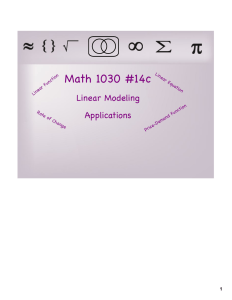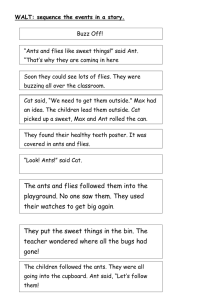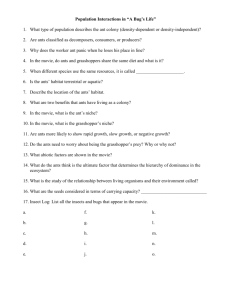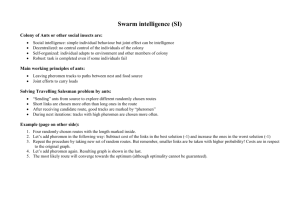The ANTZ go marching!
advertisement
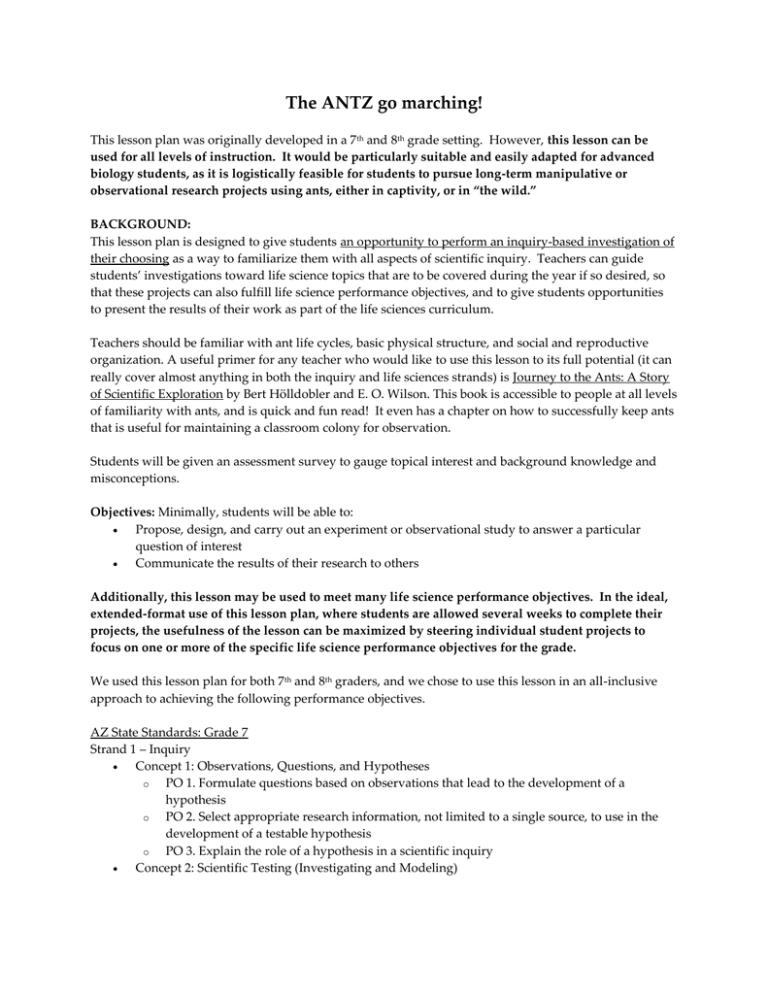
The ANTZ go marching! This lesson plan was originally developed in a 7th and 8th grade setting. However, this lesson can be used for all levels of instruction. It would be particularly suitable and easily adapted for advanced biology students, as it is logistically feasible for students to pursue long-term manipulative or observational research projects using ants, either in captivity, or in “the wild.” BACKGROUND: This lesson plan is designed to give students an opportunity to perform an inquiry-based investigation of their choosing as a way to familiarize them with all aspects of scientific inquiry. Teachers can guide students’ investigations toward life science topics that are to be covered during the year if so desired, so that these projects can also fulfill life science performance objectives, and to give students opportunities to present the results of their work as part of the life sciences curriculum. Teachers should be familiar with ant life cycles, basic physical structure, and social and reproductive organization. A useful primer for any teacher who would like to use this lesson to its full potential (it can really cover almost anything in both the inquiry and life sciences strands) is Journey to the Ants: A Story of Scientific Exploration by Bert Hölldobler and E. O. Wilson. This book is accessible to people at all levels of familiarity with ants, and is quick and fun read! It even has a chapter on how to successfully keep ants that is useful for maintaining a classroom colony for observation. Students will be given an assessment survey to gauge topical interest and background knowledge and misconceptions. Objectives: Minimally, students will be able to: Propose, design, and carry out an experiment or observational study to answer a particular question of interest Communicate the results of their research to others Additionally, this lesson may be used to meet many life science performance objectives. In the ideal, extended-format use of this lesson plan, where students are allowed several weeks to complete their projects, the usefulness of the lesson can be maximized by steering individual student projects to focus on one or more of the specific life science performance objectives for the grade. We used this lesson plan for both 7th and 8th graders, and we chose to use this lesson in an all-inclusive approach to achieving the following performance objectives. AZ State Standards: Grade 7 Strand 1 – Inquiry Concept 1: Observations, Questions, and Hypotheses o PO 1. Formulate questions based on observations that lead to the development of a hypothesis o PO 2. Select appropriate research information, not limited to a single source, to use in the development of a testable hypothesis o PO 3. Explain the role of a hypothesis in a scientific inquiry Concept 2: Scientific Testing (Investigating and Modeling) PO1. Demonstrate safe behavior and appropriate procedures (e.g., use and care of technology, materials, organisms) in all science inquiry o PO 2. Design an investigation to test individual variables using scientific processes o PO 3. Conduct a controlled investigation, using multiple trials, to test an hypothesis using scientific processes o PO 4. Perform measurements using appropriate scientific tools (e.g., balances, microscopes, probes, micrometers) o PO 5. Keep a record of observations, notes, sketches, questions, and ideas using tools such as written and/or computer logs Concept 3: Analysis and Conclusions o PO 1. Analyze data obtained in a scientific investigation to identify trends o PO 2. Form a logical argument about a correlation between variables or sequences of events (e.g., construct a cause-and-effect chain that explains a sequence of events) o PO 3. Analyze results of data collection in order to accept or reject the hypothesis o PO 4. Determine validity and reliability of results of an investigation o PO 5. Formulate a conclusion based on data analysis o PO 6. Refine hypotheses based on results from investigations o PO 7. Formulate new questions based on the results of a previous investigation Concept 4: Communication o PO 1. Choose an appropriate graphic representation for collected data: Line graph Double bar graph Histogram o PO 2. Display data collected from a controlled experiment o PO 3. Communicate the results of an investigation with appropriate use of qualitative and quantitative information o PO 4. Write clear, step-by-step instructions for following procedures (without the use of personal pronouns) o PO 5. Communicate the results and conclusions of the investigation o Strand 4 – Life Science Concept 3: Populations of Organisms in an Ecosystem o PO 1. Compare food chains in a specified ecosystem and their corresponding food web. o PO 2. Explain how organisms obtain and use resources to develop and thrive in: Niches Predator/prey relationships o PO 3. Analyze the interactions of living organisms with their ecosystems: Limiting factors Carrying capacity o PO 4. Evaluate data related to problems associated with population growth (e.g., overgrazing, forest management, invasion of non-native species) and the possible solutions o PO 5. Predict how environmental factors (e.g., floods, droughts, temperature changes) affect survival rates in living organisms o PO 6. Create a model of the interactions of living organisms within an ecosystem AZ State Standards: Grade 8 Strand 1 – Inquiry Concept 1: Observations, Questions, and Hypotheses o PO 1. Formulate questions based on observations that lead to the development of a hypothesis o PO 2. Use appropriate research information, not limited to a single source, to use in the development of a testable hypothesis o PO 3. Generate an hypothesis that can be tested Concept 2: Scientific Testing (Investigating and Modeling) o PO1. Demonstrate safe behavior and appropriate procedures (e.g., use and care of technology, materials, organisms) in all science inquiry o PO 2. Design a controlled investigation to support or reject an hypothesis o PO 3. Conduct a controlled experiment to support or reject an hypothesis o PO 4. Perform measurements using appropriate scientific tools (e.g., balances, microscopes, probes, micrometers) o PO 5. Keep a record of observations, notes, sketches, questions, and ideas using tools such as written and/or computer logs Concept 3: Analysis and Conclusions o PO 1. Analyze data obtained in a scientific investigation to identify trends o PO 2. Form a logical argument about a correlation between variables or sequences of events (e.g., construct a cause-and-effect chain that explains a sequence of events) o PO 3. Interpret data that show a variety of possible relationships between two variables, including: Positive relationship Negative relationship No relationship o PO 4. Formulate a future investigation based on the data collected o PO 5. Explain how evidence supports the validity and reliability of a conclusion o PO 6. Identify the potential investigational error that may occur (e.g., flawed investigational design, inaccurate measurement, computational errors, unethical reporting) o PO 8. Formulate new questions based on the results of a previous investigation Concept 4: Communication o PO 1. Communicate the results of an investigation o PO 2. Choose an appropriate graphic representation for collected data: Line graph Double bar graph histogram o PO 3. Present analyses and conclusions in clear, concise formats o PO 4. Write clear, step-by-step instructions for conducting investigations or operating equipment (without the use of personal pronouns) o PO 5. Communicate the results and conclusion of the investigation Strand 4 – Life Science Concept 4: Diversity, Adaptation, and Behavior o PO 1. Explain how an organism’s behavior allows it to survive in an environment o PO 2. Describe how and organism can maintain a stable internal environment while living in a constantly changing external environment o PO 3. Determine the characteristics of organisms that could change over several generations o o PO 4. Compare the symbiotic and competitive relationships in organisms within an ecosystem (e.g., lichen, mistletoe/tree, clownfish/sea anemone, native/non-native species) PO 6. Describe the following factors that allow for the survival of living organisms Protective coloration Seed dispersal Pollination National Standards: 5-8 Content Standard A: Science as Inquiry • Abilities necessary to do scientific inquiry • Understandings about scientific inquiry Content Standard C: Life Science • Structure and function in living systems • Regulation and behavior • Populations and ecosystems • Diversity and adaptations of organisms Content Standard E: Science and Technology • Abilities of technological design Content Standard G: History and Nature of Science • Nature of Science MATERIALS: Basic ant farm set-up A basic set-up can be accomplished using commercially available ant farms, and can be used in combination with an advanced set-up. Commercial ant farm (preferably with multiple “pods” that can be connected to each other with tubing) o These ant farms do not have a reproductive queen and are stocked with non-reproductive workers only. As a result, these ant farms have a finite lifespan of a few months. Also, ants are difficult to acquire during the winter months unless you live in the Southwest and can collect your own. This is a viable option for stocking multiple ant farms, or for re-stocking ant farms once the first ants have died. Advanced ant colony set-up An advanced set-up is accomplished using a captively-maintained ant colony with a reproductive queen. The last chapter of Journey to the Ants: A Story of Scientific Exploration details how to capture and maintain entire ant colonies of small ant species, but by far the easiest way to get a colony is to capture reproductive individuals when they are out for their nuptial flights. Your local ant biologist and the nearest university will know when and where to look, and will be able to give you lots of advice on how to get your colonies started and thriving. In fact, he or she may be out collecting in the spring for him or herself, and may be willing to take you along. See below for tips for getting your ant colony started. An advanced set-up can be used in combination with a basic set-up, and this is recommended, because the commercial ant farms will be more suitable for use with some projects than others, because they are essentially expendable (having no reproductive individuals). This lesson plan was designed for use with harvester ants, but it is possible to culture other ant species in the lab as well. You can use whatever is locally available. One well-started ant colony (with more than just one or two workers) Supplies for both ant farm and any colony set-ups Under-tank heater (available in the reptile care section of a pet-store) Reptile thermostat (available in the reptile care section of a pet-store) o Ants will do well at room temperature (77 degrees F), but my school is quite cold! I will maintain the at least some chambers of the ant farm at 82 degrees F, and the brood chamber of the ant colony will be maintained at 82°F . Flexible plastic tubing (for attaching additional chambers, food receptacles, etc.) Additional small plastic, lidded containers (to serve as additional chambers, for food trials, etc.) Food: commercial grass seed, occasional insects—these can be captured and cut into pieces, e.g., crickets, mealworms, roaches, etc. Water source—could be a test tube filled with water and stopped with a cotton ball, a paper towel that can be re-moistened, drops of water on the bottom of a container. Avoid bowls of water, because the ants can become trapped and drown. Testor’s brand craft paint (can be used to individually mark ants) Toothpicks Hand lenses Indoor/outdoor thermometer with probe and hi/low memory (can be found at Home Depot) Materials for observations of wild ants Small wooden stakes and marking tape (students may wish to cordon off ant hills around school grounds for observation) Long insect tweezers (students may wish to collect wild ants for closer inspection in the lab) Insect collection jars (just something plastic and see-through with a lid) Notes on classroom set-up and maintenance of an ant colony The ant colony will have a queen, and some workers. The queen will be housed in a brood chamber constructed of a test tube partially filled with water and then blocked with a cotton ball. This provides a humid, but not wet, atmosphere for raising the brood. This brood chamber can be placed within a larger container, where forage can be supplied to the ants. For harvester ants, commercially available Kentucky blue grass seed is suitable, and this can be supplemented with cricket parts (it is easier for the ants to access the tasty parts of the crickets if you cut them up, because they don’t deal well with the tough exoskeletons). The container in which you keep your ants should have a lid. Harvester ants do not climb well, so there is no need to coat the sides of the container with anything to prevent the ants from climbing out. This is handy when you need to do colony maintenance, because need not worry that the ants will climb out while you have the top of the container removed. When the water from the brood chamber is mostly evaporated, provide the colony with an additional test tube with water blocked by a cotton ball. Once the original brood chamber becomes too dry, the ants will move the brood into a more suitable spot. Then, you can replenish the original brood chamber and replace it. There are many ways to set up the ant colony as described in Journey to the Ants. To ensure that your ants are provided with an optimal brood chamber, it may be wise to always provide them with a couple of test tubes half-filled with water and blocked with a cotton ball just to give them as many choices as possible. Before taking your ant colony into the classroom, it will be necessary to find out what the temperature is like in your classroom. You should aim to maintain at least the brood chamber of your ant colony set-up at 82°F so that the colony will continue to reproduce at a good rate. You can do this using your indoor/outdoor thermometer. Place it where you plan to keep the colony, and determine the minimum and maximum temperatures at that spot. Likely, you will need to heat your colony to keep it near 82°F. Install your under-tank heater where you would like to set up your colony. The under-tank heater can be affixed to a large ceramic tile, or it can be used unaffixed. Bring in a mock set-up of your brood chamber—a box of similar material and size—and place part of it on top of your under-tank heater. Affix the probe of your thermometer inside your colony enclosure. You want to know the temperature of the place where you’re going to put the brood chamber so you don’t cook or freeze your ants. Affix the probe of the thermostat to either the under-tank heater itself, or to the box where it contacts the undertank heater, or to the tile to which you’ve affixed your under-tank heater. Plug your under-tank heater into the thermostat and the thermostat into an electrical outlet. The thermostat will turn the under-tank heater on an off to maintain a set temperature of your choosing. Take a few days to adjust the thermostat so that it is achieving a temperature of around 82°F in the colony enclosure. Once this is done, you can bring your colony in to the classroom and keep it sufficiently warm. When you first bring your colony in, make sure you put your thermometer probe in the box with the brood chamber(s), and keep a close eye on the temperature. Adjust the thermostat if necessary. Now your ant colony is ready to reproduce and grow for your students in the classroom! With a little luck and some dedication, you can use this colony in your classroom for years! TIME REQUIRED: This lesson plan will take a minimum of 7-8 school days, but will be most useful of student projects are allowed several weeks for completion and presentation of results. The days spent on the lesson need not run consecutively, and students need not work every day (or all class period) on extended projects, so this lesson can be inserted into the regularly scheduled curriculum at your convenience (though naturally, it would make more sense if the first several days of the lesson plan were executed near the beginning of the life science curriculum to allow more time for group projects to be completed). PROCEDURE: DAY 1 Introduce students to the life science performance objectives for their grade, or to the life science performance objectives you wish to cover using this lesson. Ask students to ask a question about the ants and design an investigation of that question that can be related to one of the life science performance objectives. Introduce students to the materials you have available for them to use, and remind them that they can also observe ants outside, and they can bring in materials that may be appropriate for their projects (e.g., other kinds of seeds for food preference experiments, sticks of different sizes to place in the way of ant trails outside, etc.) Hand out “Getting to know the ants” (Formative assessment questionnaire) and collect. Goals: Provide teachers with ideas about student interests, student content knowledge, and to allow teachers time to think about the best group-formation strategies for student projects. Ideally, students should work cooperatively on a project of their own interest to reduce the number of animals needed to answer each question (this can be introduced as an ethical issue as well as a logistical one). However, teacher-management of groupings may be necessary to ensure positive and productive group dynamics. DAY 2 Pre-lesson activity Watch the hour-long video: Supersocieties from the series Life in the Undergrowth, narrated by David Attenborough (check your library, and NetFlicks also carries it) Have students complete “Now that you know the ants better” and collect. (After watching the video, students may have different questions they want to answer than they did before watching the video) Goals: To provide students with some background knowledge about ants in a fun an accessible way. To generate interest in doing an ant-related project. Teacher prep. Using the project ideas articulated by students in “Now that you know the ants better” and “Getting to know the ants,” teachers will need to decide how best to organize students in groups that can work together on designing and executing a research project. Some research projects may need some shaping into projects that can be related to a desired performance objective. Some projects may not be possible due to logistical constraints. Plan suggestions to encourage students to modify their project ideas in these cases. Lab exercise DAY 3 Give students the project evaluation criteria and review it with them. They will know from the beginning what you expect from them during project execution. Organize students into groups and have them work together to formalize their project idea and write out their planned project procedure. Have them pay attention to clearly articulating their hypotheses. Have students include how many days of observation/experimentation their project will entail. Students need to consider how much time their projects will take to complete. Teachers check on students during this stage to ensure that projects are designed properly and that student time goals are reasonable and suitable given other curriculum constraints. Teachers will help students with planning project time management. Not all projects need take the same amount of time. Some questions will require more time to answer than others. Teachers may want to consider whether extensive projects can be used as science fair projects, etc. Have students plan what their data analysis will be and how they will present their results to their classmates (could be a powerpoint, a large poster, etc.--all components will ideally involve an oral presentation of results). Throughout the research project, students should record their procedures, observations, data, and any relevant background information they have used in a lab journal. DAYS 4 Have students carry out their research projects. Teachers will oversee and assist with guiding observations, asking further questions, etc. during the research process. Upon completion of students projects, have students analyze their results and complete a presentation to be given to the class (or to younger classes). Schedule student group presentation of results as desired. Not all groups will finish at the same time, so you might choose to schedule them one at a time throughout the block, or all at once at the end of the block, according to your scheduling needs. Getting to know the ANTZ! Name: 1) What would you like to know about ants? (This will be the question that you will design your project to answer.) 2) How would you design a project/experiment to find the answer (or answers) to your question? 3) What do you already know about the answer to your question? 4) What do you already know about ants that might be related to your question, even if it doesn’t answer the question directly? Now that you know the ants better . . . Name: 1) Now that you know a little bit more about ants, what would you like to know about ants? (This will be the question that you will design your project to answer. It can be a new question, or you can stick to or slightly change your old question.) 2) How would you design a project/experiment to find the answer (or answers) to your question? 3) What do you already know about the answer to your question? 4) What do you already know about ants that might be related to your question, even if it doesn’t answer the question directly? EVALUATION: Formative assessment, pre-project Use “Getting to know the ANTZ!” and “Now that you know the ants better” worksheets to assess What students think about ants What students know about ants Student misconceptions Student sophistication in designing projects to answer their questions of interest Where students need help in designing projects to answer their questions of interest Formative assessment, during project “Time for reflection” At least once during the project (you decide when for each project), students must answer in their lab notebooks: “How are your ideas about your results different from your ideas about what your results would be in the beginning? AND What do you think about now about whether your results are leading you toward one conclusion or another?” Summative assessment of scientific inquiry abilities Students must present in their final presentation: 1) What were some new questions that developed during your project/experiment? Individual summative assessment of scientific inquiry abilities Individually, students should turn in a written answer to the following: “Now you are an ant researcher!” 2) Choose one of these new questions and explain how you would design a research project to answer this new question (here you are not limited by staying in Arizona, you have unlimited lab resources, but you STILL must think about being conservative about the number of ants you use and the potential for damaging/disturbing the environment. General assessment criteria for project grade (to be handed out to students on Day 3) This will be turned into a formal rubric with points assigned to each component by Ms. Stanley. 1) Students worked cooperatively to generate and articulate a hypothesis of interest. Project hypothesis is clearly articulated in the lab notebook, and the general importance of the hypothesis (its relevance to one of the science performance objectives) is clearly explained. 2) The project design is appropriate for addressing the project hypothesis. 3) The proposed procedures are clearly outlined. 4) Time estimates for carrying out the proposed procedures are clear and reasonable. 5) The dates and times of observations and procedures are all neatly recorded in the lab notebook (Here, it may be best for you to be using a data table. You will already have checked this with your teacher, and you will already have explained how you are going to do this in step 3.) 6) According to the dates and times of observations recorded in the lab notebook, students kept on track and devoted sufficient time and focused energy to the project. 7) Students completed “Time for reflection” in their notebooks and gave sufficient thought and effort to the task. 8) Students successfully analyzed their data according to the procedures and on the timeline they outlined in steps 3 and 4. 9) Students worked cooperatively to produce a public presentation of their findings, including presenting questions for future research. 10) Students completed “Now you are an ant researcher!” individually in their lab notebooks and devoted sufficient thought and effort to the task.
